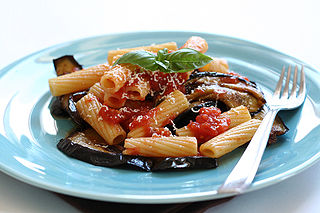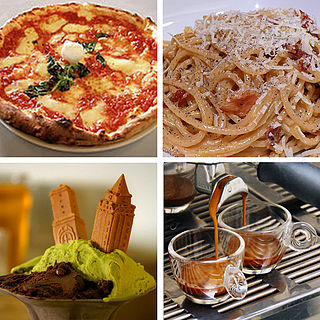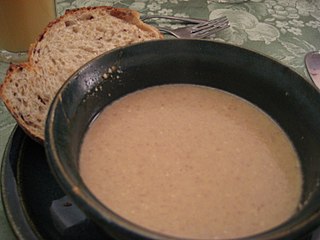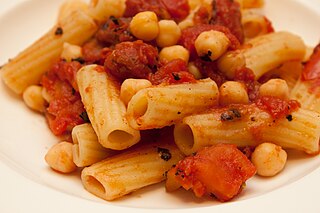
Minestrone or minestrone di verdure is a thick soup of Italian origin based on vegetables. It typically includes onions, carrots, celery, potatoes, cabbage, tomatoes, often legumes, such as beans, chickpeas or fava beans, and sometimes pasta or rice. Minestrone traditionally is made without meat, but it has no precise recipe and can be made with many different ingredients.

Pasta is a type of food typically made from an unleavened dough of wheat flour mixed with water or eggs, and formed into sheets or other shapes, then cooked by boiling or baking. Pasta was originally only made with durum, although the definition has been expanded to include alternatives for a gluten-free diet, such as rice flour, or legumes such as beans or lentils. Pasta is believed to have developed independently in Italy and is a staple food of Italian cuisine, with evidence of Etruscans making pasta as early as 400 BCE in Italy.

Sicilian cuisine is the style of cooking on the island of Sicily. It shows traces of all cultures that have existed on the island of Sicily over the last two millennia. Although its cuisine has much in common with Italian cuisine, Sicilian food also has Greek, Spanish, Jewish, Maghrebi, and Arab influences.

Italian cuisine is a Mediterranean cuisine consisting of the ingredients, recipes, and cooking techniques developed in Italy since Roman times, and later spread around the world together with waves of Italian diaspora. Significant changes occurred with the colonization of the Americas and the introduction of potatoes, tomatoes, capsicums, maize, and sugar beet—the latter introduced in quantity in the 18th century. It is one of the best-known and most widely appreciated gastronomies worldwide.

Amatriciana sauce, known in Italian as sugo all'amatriciana or as salsa all'amatriciana, is a pasta sauce made with tomatoes, guanciale, pecorino romano cheese, black pepper, extra virgin olive oil, dry white wine, and salt. Originating in the comune (municipality) of Amatrice, the amatriciana is one of the best known pasta sauces in present-day Roman and Italian cuisine. The Italian government has named it a prodotto agroalimentare tradizionale (PAT) of Lazio, and amatriciana tradizionale is registered as a traditional speciality guaranteed (TSG) in the EU and the UK.

Pasta e fagioli is an Italian pasta soup of which there are several regional variants.

As San Marino is a microstate completely landlocked by Italy, Sammarinese cuisine is strongly similar to Italian cuisine, especially that of the adjoining Emilia-Romagna and Marche regions. San Marino's primary agricultural products are cheese, wine and livestock, and cheesemaking is a primary economic activity in San Marino. San Marino participated in The Exposition Universelle of 1889, a world's fair held in Paris, France, with three exhibits of oils and cheese.

Neapolitan cuisine has ancient historical roots that date back to the Greco-Roman period, which was enriched over the centuries by the influence of the different cultures that controlled Naples and its kingdoms, such as that of Aragon and France.

Lagane e ceci or lagane e cicciari, also known as pasta del brigante, is a pasta dish originating in the Calabria region of Italy. It consists of lagane, a wide pasta, with chickpeas, garlic, and oil.

Maccu is a Sicilian soup and also a foodstuff that is prepared with dried and crushed fava beans and fennel as primary ingredients. Several dishes exist using maccu as a foodstuff, such as bruschetta al maccù and maccu di San Giuseppe, the latter of which may be served on Saint Joseph's Day in Sicily.

Ciceri e tria is a pasta dish originating in the Salento region. It is prepared with pasta and chickpeas as primary ingredients, and includes fried pasta. It has been described as a "classic and emblematic dish of Salentine cuisine" and as a specialty dish of Apulia.

The cuisine of Corsica is the traditional cuisine of the island of Corsica. It is mainly based on the products of the island, and due to historical and geographical reasons, has much in common with Italian cuisine, and marginally with those of Nice and Provence.

Walnut soup is a broth-based or cream-based soup prepared using walnuts as a main ingredient. It is sometimes prepared in combinations using other ingredients, such as "pumpkin and walnut soup". Walnut soup is a part of the cuisines of China, Italy and Mexico.

Apulian cuisine consists of the cooking traditions and practices of the region of Apulia in Italy. Starting from the Middle Ages the permanent residence of the nobility in the region gradually declined, which caused the disappearance of their noble cuisine over time. As the common people suffered from poverty, their culinary tradition adapted to use cheap and simple foods. Bread, vegetables and pasta have the leading role in the cuisine. Fruits, fish and wine are consumed frequently as well, but meat plays a minor role. The food of Apulia is known as a prime example of cucina povera or 'cuisine of the poor', characterizing its simplicity rather than its quality. Moreover, the simple dishes allow the quality of their local and seasonal ingredients to take center stage.

Pasta e ceci is a pasta dish common in southern and central Italy prepared with pasta and chickpeas as primary ingredients. It is part of the cucina povera, or peasant cuisine tradition in Italian cuisine.
U cumbitu 'i San Giuseppi, also known as u mmitu 'e San Giuseppe, or u banquettu around Catanzaro, is a custom in the Calabria region, southern Italy, in which lagane e ceci, a pasta dish containing chickpeas, is shared among families and neighbours on Saint Joseph's Day.















